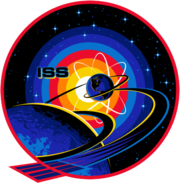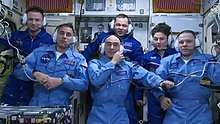Ivan Vagner
Ivan Viktorovich Vagner (born 10 July 1985) is a Russian engineer and cosmonaut who was selected in October 2010. He graduated from the Baltic State Technical University in 2008, before working as an engineer for RKK Energia.[1]
Ivan Vagner | |
|---|---|
.jpg) | |
| Born | July 10, 1985 |
| Status | Active |
| Nationality | Russian |
| Space career | |
| RSA Cosmonaut | |
Time in space | Currently in space |
| Selection | 2010 RSA Group |
| Missions | Soyuz MS-16 (Expedition 62/63) |
Mission insignia |  |
He began his first spaceflight in April 2020 as a Flight Engineer on Soyuz MS-16 and Expedition 62/63.
Early life and education
Vagner was born on 10 July 1985 in the Severoonezhsk village in the Arkhangelsk region of Russia. He attended North-Onega secondary school from 1992 to 2002 before going on to study engineering at Baltic State Technical University. In 2008 he graduated from Baltic State with a master's degree in Aeronautical Engineering.[2]
Engineering career
From 2007, Vagner worked as a design engineer for Klimov JSC, a Russian company that builds Gas-turbine engines for military and civil aircraft. The following year he went on to work at RSC Energia as an engineer, working as an assistant flight manager for the International Space Station program from February 2009 until his selection as a cosmonaut in October 2010.[1][2]
Cosmonaut career
Vagner graduated basic spaceflight training in 2012. In January 2016 he was assigned to the crew of ISS Expedition 53/54 but was removed from the flight in September 2016 due to crew cutbacks on the Russian Orbital Segment on the ISS caused by delays with the launch of the Nauka laboratory module.[2]
Expedition 62/63
Vagner was assigned to back up to Russian Flight Engineer Andrei Babkin onboard Soyuz MS-16, scheduled for launch in April 2020. Although in February 2020 Babkin and spacecraft commander Nikolai Tikhonov were removed from the flight due to a temporary health condition with Tikhonov, subsequently Vagner and Anatoli Ivanishin (Tikhonov's backup) were moved forward onto the prime crew.
He, alongside Ivanishin and NASA astronaut Christopher Cassidy launched, successfully arriving in orbit and docking with the ISS six hours later on 9 April 2020, officially joining the Expedition 62 crew alongside Roscosmos cosmonaut Oleg Skripochka and NASA astronauts Jessica Meir and Andrew Morgan, following a very short hand over period, Skripochka, Meir and Morgan departed the station aboard Soyuz MS-15 leaving Vagner and his two crew mates on board the station as Expedition 63, with Cassidy taking command.[3]

During Expedition 63, Vagner and his two crewmates are scheduled to be on board the ISS for the arrival of a number of crewed visiting vehicles. The Expedition 63 crew welcomed the Crew Dragon Demo-2 mission for a stay on board the station on 31 May 2020.[4] This flight marks the first crewed test flight of SpaceX Crew Dragon spacecraft and the first crewed spacecraft to launch from US soil since STS-135, the final flight of the Space Shuttle program, in 2011.[5] The mission is crewed by NASA astronauts Doug Hurley and Robert Behnken, who are scheduled to remain on board the ISS for two to three months.[6] The Expedition 63 crew are also scheduled to be on the ISS for the arrival of SpaceX Crew-1, the second crewed flight of Crew Dragon and the first operational mission of NASA's Commercial Crew Program, and the Second Orbital Flight Test of Boeing CST-100 Starliner spacecraft.[7] They will also overlap with the three-person crew of Soyuz MS-17 towards the end of their mission.
References
| Wikimedia Commons has media related to Ivan Vagner. |
- "Vagner, Ivan Viktorovich". spacefacts.de. Retrieved 27 September 2019.
- http://www.gctc.ru/main.php?id=164
- Clark, Stephen (16 April 2020). "Live coverage: Station crew lands in Kazakhstan". Spaceflight Now / Pole Star Publications Ltd. Retrieved 8 May 2020.
- "Crew Demo-2 Mission". SpaceX. 17 April 2020. Retrieved 8 May 2020.
- Groh, Jamie (18 March 2020). "SpaceX, NASA ready for first crewed launch from US soil in almost a decade". Teslarati. Retrieved 8 May 2020.
- "NASA, SpaceX Invite Media to First Crew Launch to Station from America Since 2011". NASA. 18 March 2020. Retrieved 8 May 2020.
- Lewis, Marie (6 April 2020). "Boeing to Fly Second Uncrewed Orbital Flight Test for NASA". NASA. Retrieved 8 May 2020.